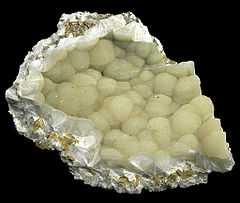Pectolite
From Wikipedia, the free encyclopedia
| Pectolite | |
|---|---|
 | |
| General | |
| Category | Silicate mineral |
| Formula (repeating unit) | NaCa2Si3O8(OH) |
| Crystal symmetry | Triclinic H–M Symbol 1 |
| Unit cell | a = 7.99 Å, b = 7.03 Å, c = 7.03 Å; α = 90.51°, β = 95.21°, γ = 102.53°; Z = 2 |
| Identification | |
| Color | Colorless, whitish, grayish, yellowish |
| Crystal habit | Tabular to acicular, radiating fibrous, spheroidal, or columnar; massive |
| Crystal system | Triclinic Pinacoidal |
| Twinning | Twin axis [010] with composition plane [100], common |
| Cleavage | Perfect on {100} and {001} |
| Fracture | Uneven |
| Tenacity | Brittle; tough when compact |
| Mohs scale hardness | 4.5 - 5 |
| Luster | Silky, subvitreous |
| Diaphaneity | Translucent to opaque |
| Specific gravity | 2.84 - 2.90 |
| Optical properties | Biaxial (+) |
| Refractive index | nα = 1.594 - 1.610 nβ = 1.603 - 1.614 nγ = 1.631 - 1.642 |
| Birefringence | δ = 0.037 |
| 2V angle | Measured: 50° to 63°, Calculated: 42° to 60° |
| Dispersion | r > v weak to very strong |
| References | [1][2][3] |
Pectolite is a white to gray mineral, NaCa2Si3O8(OH), sodium calcium inosilicate hydroxide. It crystallizes in the triclinic system typically occurring in radiated or fibrous crystalline masses. It has a Mohs hardness of 4.5 to 5 and a specific gravity of 2.7 to 2.9. The gemstone variety, larimar, is a pale to sky blue.
Occurrence

Spheroidal crystal of Pectolite (from Millington, New Jersey, USA)
It was first described in 1828 at Mt. Baldo, Trento Province, Italy and named from the Greek pektos – "compacted" and lithos – "stone".[2][3]
It occurs as a primary mineral in nepheline syenites, within hydrothermal cavities in basalts and diabase and in serpentinites in association with zeolites, datolite, prehnite, calcite and serpentine. It is found in a wide variety of worldwide locations.
See also
- Sérandite - the manganese analogue
References
External links
| Wikimedia Commons has media related to Pectolite. |
This article is issued from Wikipedia. The text is available under the Creative Commons Attribution/Share Alike; additional terms may apply for the media files.